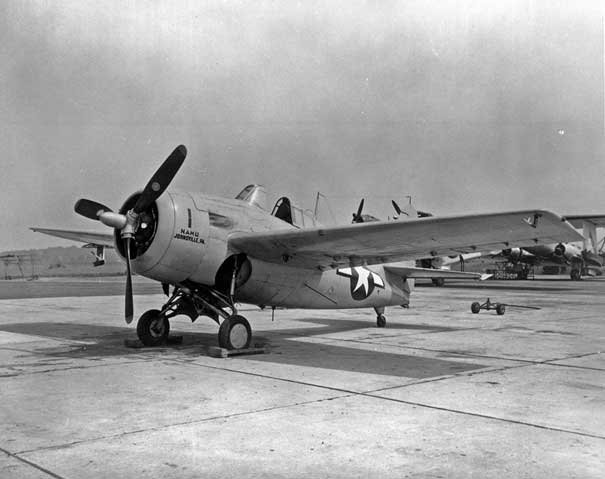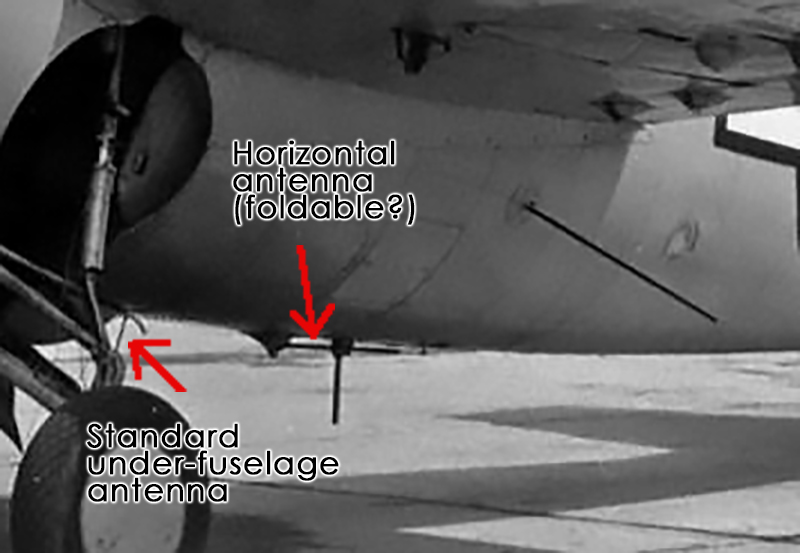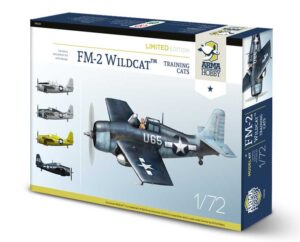 Although it may come as a surprise to many, FM-2 Wildcats were not uniquely navy blue or tri-coloured. Arma Hobby’s next kit on a scale of 1/72 contains a greater variety of paint schemes, some of which are quite enigmatic. Let’s check out what we can say about them!
Although it may come as a surprise to many, FM-2 Wildcats were not uniquely navy blue or tri-coloured. Arma Hobby’s next kit on a scale of 1/72 contains a greater variety of paint schemes, some of which are quite enigmatic. Let’s check out what we can say about them!
Yellow 1, 3 – NAMU, Johnsville.
Eye-catching, bright yellow Wildcats from Johnsville Naval Air Station. To start off, let’s decipher the abbreviation NAMU. It stands for Naval Aircraft Modification Unit. Common sense would suggest, quite rightly, that its task consisted in making modifications to Navy aircraft. It was located on the factory airfield of Brewster Aeronautical Corporation. As a result of various perturbations and manufacturing problems, this facility had been taken over by the government and handed over to the United States Navy.
The NAMU was mainly involved in adapting monoplanes to Navy requirements, but it also worked on conceptional projects and tested new solutions relating to aeroplane armament and communications equipment. For example, it led the field in fitting “maritime” aircraft with radars, and was also involved in the construction of drones.
Having this specific mission profile in mind, experienced observers will notice that the FM-2 carrying the number “1” has a few non-typical antennas. One is long and protrudes from the left side of the fuselage underneath the wing, running downwards at a slant, while the next, shorter in length, is installed along the axis of the fuselage; please note, however, that the latter is not the standard under-fuselage antenna that can be seen on front-line aeroplanes. It is considerably thicker, and – crucially – its location is different (the standard antenna is also in place, however it is hardly visible in the photograph).
When looking at the photograph in its original size, it is difficult to discern anything more, however in close-up we can see one more antenna, which runs along the fuselage to the rear. It looks as if it were “folded” backwards.
The second aeroplane (no. 3) that you can make using our set of transfers has fewer antennas. Specifically, it has one short antenna under the fuselage (in addition to the standard one, which can also be seen). Whereas this variant is dragging something behind it on a cable… We do not know, however, whether this is a target or some item of test equipment.
Both aircraft also have the standard cable antenna strung between the fuselage mast and the vertical stabilizer, running downwards from the mast to the left side of the fuselage. Interestingly, the antenna set includes one additional cable, which goes from the mast to the right horizontal stabilizer. It is difficult to see, but it is there!
FM-2 Number U-65
Our “title” FM caused me no end of trouble… Two sources described it completely differently. When creating the transfers and developing the colour profile, I made use of a 2004 edition of “In Action”. In it, the aeroplane is described as belonging to a Carrier Aircraft Service Unit (CASU) (however no unit number is given) and flying over Marine Corps Air Station Eva in Hawaii. An additional source which I found is “F4F Wildcat In Detail and Scale”, which was printed by the same publisher four years earlier, in 2000. This states that the aircraft is from an Operational Training Unit (OTU) and is flying over Naval Air Station Jacksonville in Florida in late 1944. So there you have it – take your pick. I dug through the internet in search of information… Frustratingly, I found nothing that would have solved the problem outright. But… It is well-known that the base in Jacksonville was huge, and basically all pilots who were trained during the Second World War were sooner or later bound to pass through it. Therefore, this line of line of reasoning could very well be correct. Unfortunately, I found nothing regarding the code designation U-65. Only that such a LETTER/NUMBER arrangement, painted in white on the fuselage, denoted a training aircraft. Obviously, a great many aeroplanes with very distinct code markings would have been transferred through a base the size of JAX…
It was similar, I think, with the CASU units, which readied the aircraft and ferried them to the front line. But the worst part for me was that although CASU units were actually set up at specific airfields/bases, they too, while being en route to the theatre of operations, could have stopped over at JAX. Finally, after numerous analyses, I stumbled on a thought… In Jacksonville, operational training for fighter pilots (i.e. utilising aircraft that would later be flown by specific pilots) took place at Green Cove Springs Naval Auxiliary Air Station, which was located some 20 miles south of Jacksonville. I found a good many photographs of the area, and of JAX itself. All show that the terrain is rather flat… There are no hills. Marine Corps Air Station Eva is located in Hawaii, and, as we all know, there are mountains there …
I played around with contrast in Photoshop, and, all of a sudden… These are not clouds but mountains! It turns out that the more recent “In Action” article could have indeed been right. Further, Hawaii also served as a stopover point for many American air force units heading off to war. Since, however, our aeroplane does not have a gunsight, I concluded that it was not being ferried to the theatre of operations. Hence, it had to be a training aircraft. We decided to use this source, and have described our model accordingly.
 Intriguingly, sometime later we came upon a very interesting page on Flickr. It contains a photograph of a PBY Catalina with markings identical to those of our Wildcat, parked in Pearl Harbour, Hawaii, in 1945! Quite obviously, this does not have to mean anything, however it confirmed us in our belief that we had “probably” taken the correct decision.
Intriguingly, sometime later we came upon a very interesting page on Flickr. It contains a photograph of a PBY Catalina with markings identical to those of our Wildcat, parked in Pearl Harbour, Hawaii, in 1945! Quite obviously, this does not have to mean anything, however it confirmed us in our belief that we had “probably” taken the correct decision.
Pearl Harbour, 1946. A PBY Catalina: Fickr.com
Up Until Now, It Was Easy …
So you thought that the paint scheme riddle was difficult to solve? … No… the difficulties were yet to come…
The next “Cat” from our offering is the mysterious C50. And this one is a real enigma. Its silver paint scheme is certainly very atypical. Add to that the black anti-reflective stripe.
I thought that I had finally found the answer … but no. The photograph had been taken in 1943 at Naval Air Station Whidbey Island. Unfortunately, the information I gathered told me that towards the end of 1943, the Wildcats stationed there were replaced with Hellcats. Another miss.
Things being as they are, we have to limit ourselves to the information that can be substantiated. The LETTER/NUMBER arrangement was used to mark training aircraft. The black colour on a light background was also highly standard. The silver colour, although untypical of Wildcats, was introduced by regulations for advanced training aircraft with effect from March 1944.
Our source is “In Action”, in which a side view of the aeroplane was shown. But it too does not contain a photograph! The aircraft is described simply as an “Advanced Trainer”… And that’s it!
Additionally, the same profile of the aeroplane has been included in a Polish publication, in which it is described as being with a Marine Corps squadron stationed in Florida. I would really like to know whether the author had any confirmation for this, or if he just decided that such a description would be “safe”. Especially as there were a few quite large US Navy bases in Florida that were used by Marine Corps training units. All this has convinced us that we should stick with the present description of the paint scheme, although, truth be told, not much is known on the topic. But there must be a photograph of this aircraft somewhere… The drawings could not have been fabricated, there simply must be a trace… but how are we to find it? Maybe one of our readers knows the answer? I await your comments under the article.
The Greatest Riddle and the Most Intriguing Paint Scheme – LS03
For many of you, this paint scheme from the 70034 kit will be the most interesting. And indeed… a Wildcat in Atlantic camouflage, grey-white and with a clearly different engine cowling. The cowling, painted in three colours, was most probably taken as a replacement from another aircraft. What is more, interesting items of equipment can be seen underneath the wings.
We have succeeded in identifying the radio altimeter antenna. But the other device is a mystery. Perhaps you will be able to give us a clue? Additionally, the close-up clearly shows how the wire antenna was fixed to the fuselage. It is also worth noting that the aeroplane has a square pilot’s headrest. In the case of demanding modellers, choosing this painting option will necessitate a personalised modification of this element.
As regards the eye-catching markings, I would like to add that although they appear obvious and easy to identify, nothing could be further from the truth. I have not been able to find any information about the LS03 code.
Now, concerning the letter “R” on the tail … This would seem to indicate Floyd Bennett Field in New York. But only from 1947. The two JM-1s visible in the background can be used to perform some interesting comparative research. If we look closely, we will see that one has the markings “4-J-4”, while the other is coded “15-J-3”. These clearly point to VJ-4 Squadron, a part of which became the nucleus of VJ-15 Squadron. Their origins direct us to various Navy bases, such as NAS Brunswick or NAS Atlantic City … In reality, however, all this does not help us much, and I can only recommend an in-depth analysis to those who enjoy studying the history of American air stations. As regards the paint scheme of our Wildcat, this will give us nought, for the units were frequently moved to various airfields …
That is why we have described the aircraft as coming from an “unknown unit”. If any of you can contribute anything relevant, we would be grateful for reaching out to us.
The Last Of a Dying Breed…
I have left the paint scheme which is least controversial – that of the entirely navy blue Wildcat from the Marine Corps training squadron which qualified pilots in carrier landings on the aircraft carrier USS Solomons (3 May 1945) – for last. The white stripe on the engine cowling designates an advanced training aircraft.
English translation by Maciek Zakrzewski
See also:
- FM-2 Wildcat Training Cats and other Wildcat model kits in the Arma Hobby webstore
Dywizjon „Świętych” – najskuteczniejsza jednostka Wildcatów US Navy
A computer graphic artist with a passion for modeling. Only the correct 1/72 scale, planes, Pacific WW2.
This post is also available in:
 polski
polski






















